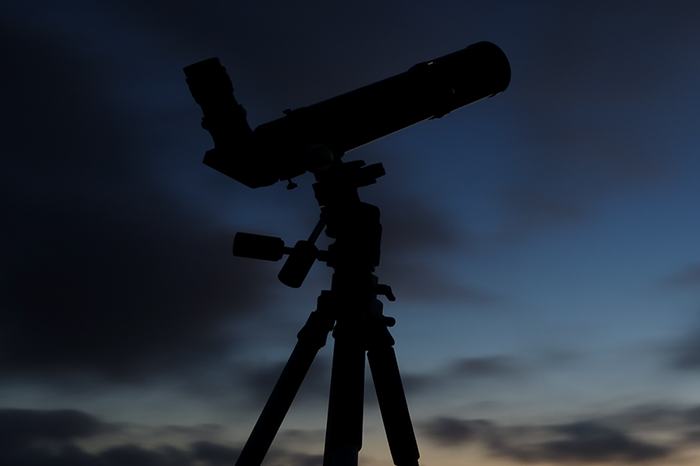My first telescope - how to choose?
How to choose the first telescope?
What to pay attention to? Refractor or reflector? Where is the best place to buy it and what parameters should it have? These are the questions that all novice astronomy enthusiasts who plan to buy a telescope ask themselves. There is certainly no definite answer to them, and buying a telescope is not a simple matter. Especially when it is our first telescope. However, we can help you make the right choice by pointing out the most essential elements in every telescope, as well as advising you to choose the right equipment for specific use. If you are still wondering which telescope to choose, be sure to continue reading our guide.

The perfect first telescope
If you are a beginner in astronomy, it is best for you to start with simple observations and equipment that is easy to use. Your first telescope cannot be too difficult to use, and more professional equipment requires knowledge and experience. Dark and distant space objects also require it, but don't worry. This does not at all mean that your observations cannot be fascinating. All the most interesting objects in our solar system require neither expensive equipment for professionals, nor much experience.
Lenticular telescope or Newtonian telescope?
Which of these telescopes will work best for visual observations? As a first telescope, a refractor, which is, above all, simple to use works very well. It is not necessary to set it up in any complicated way in order to be able to observe celestial bodies. Lenticular telescopes are also suitable for observing the Moon and planets- the largest and brightest objects. With a telescope you will look at the surface of the Moon, as well as the rings of Saturn. With it, it is also possible to make observations of the earth's landscape, since the telescope shows a straight image.
OPTICON ProWatcher telescope is an example of an interesting lenticular telescope
In addition to scopes, you also have a choice of reflecting telescopes, or reflectors. Unlike lenticular telescopes, which are made of lenses, a Newtonian telescope has mirrors. Its operation is more demanding, so a reflector is not recommended for beginner astronomy enthusiasts. It certainly works better if you want to view nebular objects, comets or faint asteroids, but you need to know how to find them, plus the right observing conditions must also be met. Think about where you will make your observations.
Since we are talking about suitable observing conditions, we must also mention that the choice of telescope also depends on them. A different piece of equipment will work well under an urban sky that is affected by artificial light, and another will allow you to observe celestial bodies where the night sky is very dark.
The matter of telescope size is also related to the place of observation. If you plan to move often, and thus transport the equipment to different places for observation, this will certainly be easier with a smaller telescope. It is also worth thinking about buying a transport case, so that it will be properly protected in transport.
Urban reflecting telescope
Making astronomical observations is not an easy task nowadays, due to very strong lighting in cities, suburban areas or even rural areas. In such conditions, a spotting scope works better. If you are not going to look for desolate and dark areas for observation, then just choosing a telescope will be a better option. You will get more high-contrast images with it, and you don't even need a large telescope to observe the planets and the Moon. You can even use even larger binoculars in observing the Moon. Smaller lenticular telescopes are also relatively inexpensive, so buying a proven and good quality piece of equipment doesn't have to break your budget at all.
Reflecting telescope for suburban observation
For observing dark objects such as galaxies and nebulae, you need a reflector. Remember, that you are not able to view these celestial bodies in urban conditions, as they require very dark skies. So it doesn't make much sense to purchase a reflector if it is to be used mainly in the city.
OPTICON Zodiac specular telescope
Refracting telescopes perform worse in artificial light than lenticular telescopes. Watching the planets under urban skies with them will not be of the same quality as observing them with a refractor. A Newtonian telescope is also more difficult to use and, for this reason, is not recommended as a first telescope. However, if you would like to choose such equipment, it will be easier to handle a Dobson mount telescope model.
What are the parameters to pay attention to?
Even if you are one of the beginner astronomy enthusiasts, it is still important that you choose a telescope of good quality. It can be determined by looking at the parameters of a particular model, as well as the quality of its individual components. For amateur purposes, you will not need the best telescopes on the market, but those with optimal parameters for beginners.
- Maximum magnification
Proper selection of magnification is essential in astronomical observations. Too much magnification, used for viewing close objects like the Moon, will make comfortable observations much more difficult. You will then see only a snippet of the object under observation. Thus, higher magnification is not at all the most important parameter, and it may even negatively affect your observations.
- Diameter of lens or mirror
This is one of the most important parameters in every telescope, because the diameter of the lens, or mirror, determines the amount of light the instrument will capture. More light means a brighter and higher-contrast image. If you want to view terrestrial objects, the Moon or other celestial bodies that are equally close to the Earth, a small refractor - with a lens diameter as small as 50-80 mm - will be sufficient for you.
More distant objects from Earth, planets such as Mars, Jupiter or Saturn, require a larger telescope - with an objective diameter of 80-110 mm. You will get the greatest contrast in a telescope with a lens diameter of 150 mm and above, but such a device is already quite large and not necessarily needed for amateur use.
Objects much more distant from Earth, such as further planets, nebulae, galaxies or star clusters, require more powerful reflecting telescopes - with mirror diameters of 110 mm and above.
- Lens speed (brightness)
Another important parameter. What we see is actually light radiation and the more we want to see the more light we have to "catch". So the brighter the telescope (the LESS the "f" parameter) the better, in theory. Of course, certain objects, such as clusters of small stars, are better viewed through a telescope with a higher f-number parameter to "get rid" of excess light entering the optical system - but that's a more complicated topic, not for this article.
In general, remember that the most universal value of the parameter "f" (suitable for most purposes) is considered to be f=10. For observation of closer objects (the Moon, Mars, Jupiter...) a telescope with f>10 is sufficient. The more distant objects you want to observe, the smaller the parameter f
To observe the Sun, we will need the "darkest" telescope possible, that is, f>10 or a telescope with any f, but then it is necessary to use a special telescope filter for observing the Sun. Remember that observing the Sun can be dangerous and requires special safety measures. If you have never done it before, it is best to start under the guidance of someone more experienced. When you choose a telescope, keep in mind where you are making observations.

- Eyeglass and eyepiece
Under this mysterious name is hidden another important parameter. This is the diameter of the tube to which the eyepiece is mounted. The telescope can be equipped with one of the following three eyepiece focusers: 0.98", 1.25" and 2". Nowadays, the most popular eyepiece is 1.25", so choosing a telescope with just such a diameter will allow you to replace eyepieces, planetary filters or other high-quality accessories without any problems. Connecting pieces for them are produced in mainly two standards: 2" and 1.25".
The choice of a good quality eyepiece is also of huge importance, since the field of view depends on it, as well as the possibility of higher magnification. To calculate the last parameter, you need the focal length of the telescope and the focal length of the eyepieces.
- Stable installation
This is, despite appearances, a very important detail. Remember that the objects you are observing are located very distantly. Moving the telescope by only a fraction of a millimeter can lead to the fact that at this "very far" distance, the movement will be so large that, as a result, the viewed object will disappear from our field of view.
If we want to observe terrestrial objects, the Moon, as well as the planets that are "near Earth", then an azimuth mount is completely sufficient. Compared to other celestial bodies, they are quite close to us, so they will not disappear so quickly from the field of view, and it is not necessary to regulate the telescope so precisely.
For observing farther objects, a parallactic mount may be necessary, due to its precise adjustment and the possibility of using a special stepper motor. Thanks to it, it is possible to automatically "follow" the telescope tube following the moving object. Remember that the further objects you observe, the faster their image disappears from the field of view.
Compare telescope dimensions
What else might be useful to you?
You already know what construction to choose for your first telescope and what it should have if you want to make observations of the planets, the Moon or other space objects. Of course, these are not all the important issues related to the selection of a telescope, and we still need to draw your attention to some more points. When choosing a telescope, let's check the components included in the kit.
Always choose a telescope that uses glass optics, that is, lenses made of glass. It is also worth having extra eyepieces, a Barlow lens, as well as a finder and sky maps, which will help you to locate an object more easily. Sometimes manufacturers or sellers place great importance on the possibility of obtaining a huge magnification in a given telescope, but you already know that this is not at all the most important parameter. Much more depends on the diameter of the telescope.
Don't buy a telescope from a hypermarket or photo store
The products offered there only bear the name of a telescope, and unfortunately that is where their similarities end. Poor quality of optical components, unstable mount and lack of warranty or instructions, can effectively discourage you from this passionate hobby of astronomy. It is best to buy your first telescope, and every telescope thereafter, from a specialized store, where you will find high-quality goods that you will use for many years.
In such places you can also count on qualified staff to answer any of your questions. This is very important, because the parameters given above are only the beginning of what you should pay attention to when it comes to buying a telescope. In addition to them, a whole host of other dependencies matter (observation sites, eyepieces, filters, types of telescope construction, etc.) and it is worth asking more experienced people about them.
If you follow the above tips, you will certainly increase your chances of making sure that the telescope you choose does not become just another impractical thing. Instead, it will actually be a useful tool, allowing you to discover a wonderful world that you may not have even known existed.
Check out our range of astronomical telescopes and start an amazing adventure now!
Check out similar entries:



